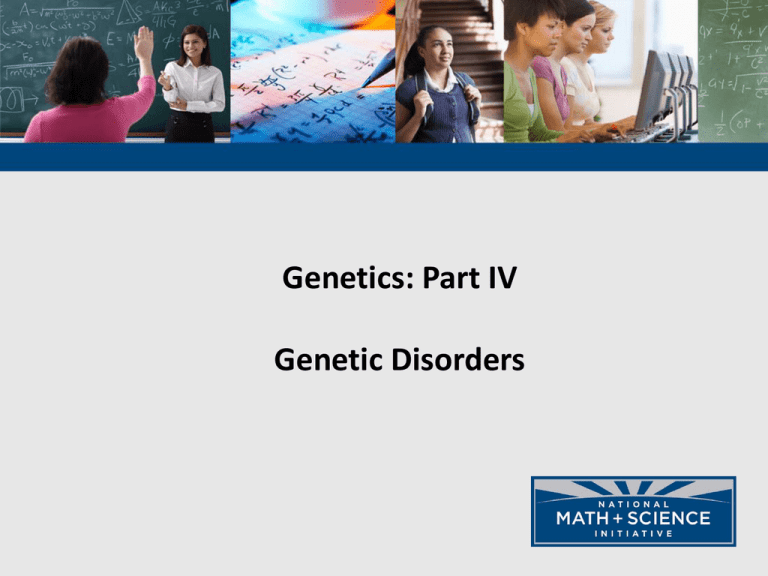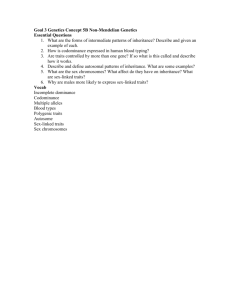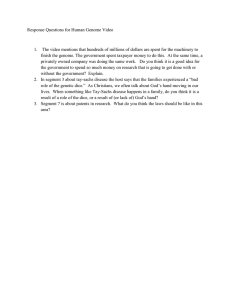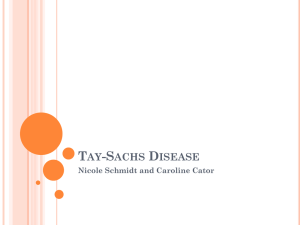04 Genetics- Disorders_RD_MP
advertisement

Genetics: Part IV Genetic Disorders What has gone wrong? 2 Curriculum Framework • c. Certain human genetic disorders can be attributed to the inheritance of single gene traits or specific chromosomal changes, such as nondisjunction. illustrative examples: •Sickle cell anemia •Tay-Sachs disease •Huntington’s disease •X-linked color blindness •Trisomy 21/Down syndrome •Klinefelter’s syndrome Curriculum Framework 3.A.4.b Some traits are determined by genes on sex chromosomes. Illustrative examples • Sex-linked genes on sex chromosome (X in humans) • In mammals and flies, the Y chromosome is very small and carries few genes Small change, Big problem 5 Sex Linked Traits • Traits carried on the sex chromosomes are said to be sex linked. • In humans, most sex-linked traits are carried on the X chromosome. • Sex-linked traits are expressed more often in human males than females. 6 Example of Sex Linked Trait: Hemophilia 7 Probability? What is the probability that the son of a carrier female and a normal male will have hemophilia? 8 Probability? What is the probability that the son of a carrier female and a normal male will have hemophilia? 9 Imagine a genetic counselor working with a couple who have just had a child who is suffering from Tay-Sachs disease. Neither parent has Tay-Sachs, nor does anyone in their families. Which of the following statements should this counselor make to this couple? a. “Because no one in either of your families has Tay-Sachs, you are not likely to have another baby with Tay-Sachs. You can safely have another child.” b. “Because you have had one child with Tay-Sachs, you must each carry the allele. Any child you have has a 50% chance of having the disease.” c. “Because you have had one child with Tay-Sachs, you must each carry the allele. Any child you have has a 25% chance of having the disease.” d. “Because you have had one child with Tay-Sachs, you must both carry the allele. However, since the chance of having an affected child is 25%, you may safely have thee more children without worrying about having another child with Tay-Sachs.” Example of Sex Linked Trait: Colorblindness 11 Color blindness Draw a Punnett Square to show how a color blind male could produce a family containing colorblind females. 12 Is your Punnett Square like this one? 13 Nondisjunction 14 Nondisjunction 15 Trisomy 21 16 Down syndrome patients have noticeable traits 17 18 Huntington’s Disease: A Late-Onset Lethal Disease • Huntington’s disease is a degenerative disease of the nervous system • The disease has no obvious phenotypic effects until the individual is about 35 to 40 years of age • Once the deterioration of the nervous system begins the condition is irreversible and fatal Lethal Dominant Trait Huntington’s affects people after reproduction age so it continues to be maintained in a population 20 Envision a family in which the grandfather, age 47, has just been diagnosed with Huntington’s disease. His daughter, age 25, now has a 2-yearold baby boy. No one else in the family has the disease. What is the probability that the daughter will contract the disease? A. 0% B. 25% C. 50% D. 75% E. 100% NONNUCLEAR INHERITANCE 22 Curriculum Framework • 3.A.4.c. Some traits result from nonnuclear inheritance • 1. Chloroplasts and mitochondria are randomly assorted to gametes and daughter cells; thus traits determined by chloroplasts and mitochondrial DNA do not follow simple Mendelian rules. • 2. In animals, mitochondrial DNA is transmitted by the egg and not by the sperm; as such, mitochondrial-determined traits are maternally inherited. 23 24 Mitochondrial Inheritance • Sometimes referred to as Maternal Inheritance • More than 40 known human disorders are attributed to mitochondrial inheritance. • Links have been made between mtDNA and diabetes, certain cancers and aging just to name a few. 25 Curriculum Framework • 3.A.3.d • Many ethical, social and medical issues surround human genetic disorders. • Illustrative examples – Reproduction issues – Civic issues such as ownership of genetic information, privacy, historical context 26 Would you want to know? 27 Created by: Debra Richards Coordinator of K-12 Science Programs Bryan ISD Bryan, TX








